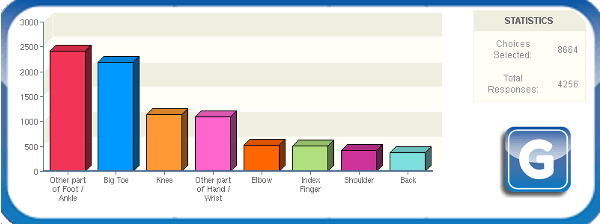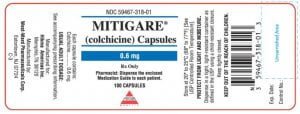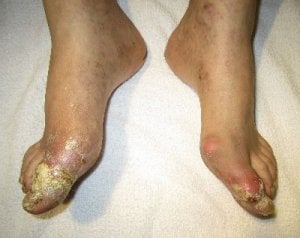The main symptoms of gout are usually considered to be a red, swollen, extremely painful big toe.
Other gout sufferers and I have even had a gout diagnosis turned down because we did not present these common symptoms.
Yes, a swollen big toe is a common symptom of gout, but as we will see, it only affects just over half of gout sufferers.
Symptoms Of Gout Survey

The survey was in two parts: one question on types of gout symptoms, and the other on joints affected.
Types of Gout Symptoms Survey
I will publish the symptoms of gout survey for types of gout symptoms soon.
Joints Affected by Gout Survey
We can see from the total number of joints affected by gout, compared to the total number of people who recorded their symptoms, that on average, gout sufferers have two affected joints. I have not segmented the analysis to show how many people have 1, 2, 3 etc joints affected. If you want to see that breakdown, please discuss this in the gout forums.
I’ve included earlier percentage results from the chart as I published it in 2007[1].
Joints Affected by Gout Survey Results
| Joint Affected by Gout | Count | Percent | 2007 % |
|---|---|---|---|
| Other part of Foot / Ankle | 2422 | 57% | 57% |
| Big Toe | 2184 | 51% | 57% |
| Knee | 1133 | 27% | 29% |
| Other part of Hand / Wrist | 1102 | 23% | 22% |
| Elbow | 527 | 12% | 13% |
| Index Finger | 503 | 12% | 12% |
| Shoulder | 417 | 10% | 11% |
| Back | 376 | 9% | 7% |
The table is in count order, but questions were asked in a different sequence. Thus: Other part of Foot / Ankle means other than the Big Toe, and Other part of Hand / Wrist means other than the Index Finger.
Understand Symptoms of Gout
Of course, the joint of the big toe that is normally affected by gout, is on the side of the foot, so people may have inadvertently described it incorrectly. Nevertheless, the other joints are significant, and for anyone who understands gout, this is to be expected.
Firstly, uric acid crystals form more readily in the extremities, where temperatures are lower. So for most people, this is a risk factor in the hands as well as the feet. More significantly, untreated gout will spread to all joints, and beyond. Many gout patients do not get told the all-important fact, as determined by professional rheumatologists. If you have ever had a gout attack, uric acid should never be allowed to rise above 5mg/dL (0.30mmol/L).
Manage Your Symptoms of Gout
You will see in the Gout Treatment pages that there are many ways to control uric acid, but you can only do this if you know your number, and check it at least once per year. Correct diagnosis of your symptoms of gout is your first step to Gout Freedom. Whenever you see your doctor about gout, be sure to get your blood tested for uric acid. Also, be sure to learn the exact number. Do not be fobbed off with phrases like “normal” or “not too high”.
If you have experienced different symptoms of gout, please share your story in your gout symptoms discussion. Or use the Feedback Form below.
Leave Symptoms of Gout to browse other Gout Symptoms pages.
Symptoms of Gout References
- Taylor, K. (2007). Which Of Your Swollen Joints Has Gout?. [online] GoutPal.com. Available at: https://web.archive.org/web/20071012052611//swollen-joints.html [Accessed 3 Mar. 2020].
Symptoms of Gout Page Status
See the status page for history and optional work in progress notes. You can help to improve this page. Either click that Status Page link. Or use the Feedback Form below.
Please give your feedback
Did this page help you? If yes, please consider a small donation. Your donations help keep GoutPal's gout support services free for everyone.
If not, please tell me how I can improve it to help you more.
- YouTube
- The gout forums.










